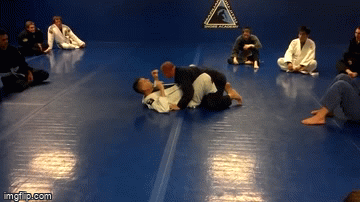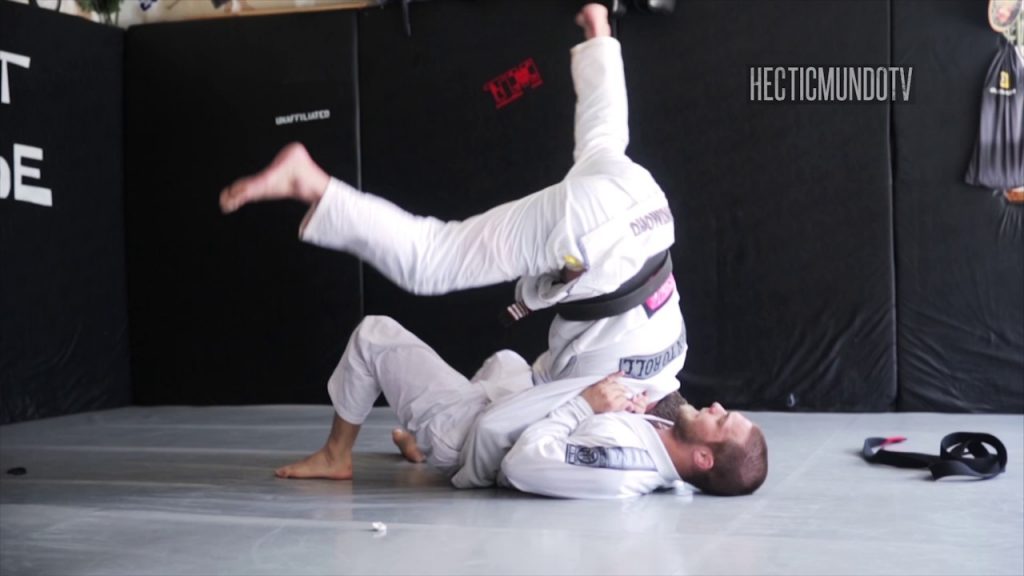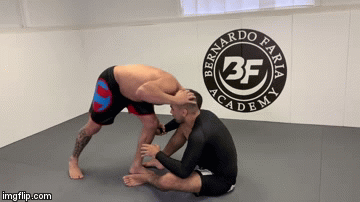
Going upside down in Brazilian Jiu-Jitsu is not something that we’re not used to. Granby rolls, inversions, Tornado guard and a bunch of other crazy stuff gets people in the weirdest inverted positions. However, they all have to do with being on your back and having to fight off the ground. But have you ever thought about going upside down when you’re on top, trying to pass the guard or hold top position? Handstands are a great example of going upside down while you’re on the top. However, developing them will require meticulous repetition of several BJJ handstand drills.
Handstands are not unheard of in grappling. Wrestlers do the craziest things while standing on their hands like cartwheels and one-hand flips. In BJJ, where positions on the ground are even more numerous, handstands are very underused. Personally, I stumbled across them while doing gymnastics as a means of conditioning. It turns out, BJJ handstand drills will open up new and exciting ways for you to confuse opponents and have lots of fun when rolling.
How To Do A Proper Handstand
Handstands are hard! Unless you’ve been practicing gymnastics from a very early age, or are really into breakdancing you’ll have a tough time doing a handstand. Don’t’ believe me. Ok, try one. Go and do a handstand, unsupported by a wall, and stay in it for a minute. If you can do it, try walking on your hands. If you can do both, you’re ready to implement handstand stuff in your BJJ game.
90 % of people reading this (and I’m being generous here) will not be able to achieve this, though. That doesn’t mean that you’ll never be able to do a handstand. It will just take a bit of practice to figure out how a handstand works as a position before you implement it in you Jiu-Jitsu game. Just like with BJJ positions.
For handstands, you have one prerequisite – wrist mobility. If your wrists are weak, it is the first thing you need to address, as most of the mechanics behind a handstand are based on wrist strength, and stability. On top of pointers for holding one, think posture. Just like in BJJ the spine needs to be in posture, meaning your head should be looking straight ahead, not trying to gaze towards the ground. Fingers wide, elbows straight and rotated outwards, and shoulder blades open. Tighten the core and you’ve got all the cues you need to develop a free-standing handstand in record time.
BJJ Handstand Drills
BJJ handstand drills are different kinds of drills. Once you know how to do a handstand, you won’t really have much use for it in grappling, unless you modify it to fit your needs. BJJ handstand drills will have you practice handstands against an opponent and by placing your hands on uneven surfaces. Sometimes, to do a handstand based move in BJJ, you’ll have to have a hand on the opponent, or holding a Gi, rather than just placing the palm down like for a regular handstand.
A great drill would be to try and get into a handstand every time you’re passing the guard. You don’t have to finish the pass each time you try. All you need to do is to get a handstand, go back, and try again or use a pass. The trick is finding the sweet spot for going into a handstand, while an opponent has grips and is trying to sweep you. Long story short, there’s hardly a sweep if they can’t get to your legs. Going upside down will really limit their options.
Another option is using handstand to actually sweep people. To achieve this you’ll need to focus your time and effort on drilling ways of getting to a handstand from the ground. This is, arguably, the hardest way of getting into leg locks. Doing a handstand press (it is a gymnastic exercise) is hard on its own, let alone done in grappling. However, there are ways to transition using the grips and inertia from a grappling exchange. The goal of drilling this is to look for that perfect moment to transition into a handstand of sorts.
What To Do With Handstands In BJJ
As I said previously, you can do whatever you want with handstands in a grappling exchange. If you’re confident enough about your handstanding abilities, of course. Form guard passing, to sweeping, even some submission setups (like rolling chokes) all become a lot easier when going on your hands is an option. Plus, the confusion on people’s face is priceless whenever you pull off a BJJ handstand-based move.
Passing Guard

Switching Sides

Back Takes

Wrapping Up
Figure out fun ways of learning handstands if you don’t know them. Yoga is a great way to really get the hang of them. For the purposes of Jiu-Jitsu, do BJJ handstand drills that will allow you to put your new athletic skill to a sport-specific use. Apart from that, enjoy and watch as opponents are mesmerized when you sweep, pass or submit them while being upside down.


![Darce Choke Encyclopedia – Origins, Mechanics and Variations [2025] BJJ, choke, Brabo, BJJ Darce Choke, D'arce Choke, Darce BJJ Choke](https://bjj-world.com/wp-content/uploads/2017/11/JungPoirierLeeYahoo-218x150.jpg)









![X-Guard Trickery Kyle Sleeman DVD Review [2025] X-Guard Trickery Kyle Sleeman DVD Review](https://bjj-world.com/wp-content/uploads/2025/03/x-guard-trickery-kyle-sleeman-dvd-review-218x150.png)
![Countering with Crab Ride Anthony Budion DVD Review [2025] Countering with Crab Ride Anthony Budion DVD Review](https://bjj-world.com/wp-content/uploads/2025/03/countering-with-crab-ride-anthony-budion-dvd-review-218x150.png)
![Closet Closed Guard Craig Jones DVD Review [2025] Closet Closed Guard Craig Jones DVD Review](https://bjj-world.com/wp-content/uploads/2025/03/closet-closed-guard-craig-jones-dvd-review-218x150.png)
![Xanadu Back Takes Levi Jones-Leary DVD Review [2025] Xanadu Back Takes Levi Jones-Leary DVD Review](https://bjj-world.com/wp-content/uploads/2025/03/xanadu-back-takes-levi-jones-leary-dvd-review-218x150.png)

![No-Gi Grapplers Guide To Front Headlock Joel Bane DVD Review [2025] No-Gi Grapplers Guide To Front Headlock Joel Bane DVD Review](https://bjj-world.com/wp-content/uploads/2025/03/no-gi-front-headlock-joel-bane-dvd-review-218x150.png)
![Leg Lock Strategies: Navigating Entanglements Jack Stapleton DVD Review [2024] Leg Lock Strategies: Navigating Entanglements Jack Stapleton DVD Review](https://bjj-world.com/wp-content/uploads/2024/12/navigating-entanglements-jack-stapleton-dvd-review-324x235.png)


![Dima Murovanni Kill The Collar Tie BJJ Trendsetters DVD Review [2024] Dima Murovanni Kill The Collar Tie BJJ Trendsetters DVD Review](https://bjj-world.com/wp-content/uploads/2024/09/dima-murovanni-kill-the-collar-tie-dvd-review-100x70.png)

![No-Gi Grapplers Guide To Front Headlock Joel Bane DVD Review [2025] No-Gi Grapplers Guide To Front Headlock Joel Bane DVD Review](https://bjj-world.com/wp-content/uploads/2025/03/no-gi-front-headlock-joel-bane-dvd-review-100x70.png)
![A Blueprint For Smeshing Khabib Nurmagomedov DVD Review [2024] A Blueprint For Smeshing Khabib Nurmagomedov DVD Review](https://bjj-world.com/wp-content/uploads/2024/10/blueprint-for-smeshing-khabib-nurmagomedov-dvd-review-100x70.png)


![Just Pass Jay Rodriguez DVD Review [2024] Just Pass Jay Rodriguez DVD Review](https://bjj-world.com/wp-content/uploads/2024/11/just-pass-jay-rodriguez-dvd-review-100x70.png)
![Welcome To The Darce Side Travis Moore DVD Review [2025] Welcome To The Darce Side Travis Moore DVD Review](https://bjj-world.com/wp-content/uploads/2025/01/welcome-to-the-darce-side-travis-moore-dvd-review-100x70.png)





![Intro To Hip Mobility for Guard Players Joshua Presley DVD Review [2024] Intro To Hip Mobility for Guard Players Joshua Presley DVD Review](https://bjj-world.com/wp-content/uploads/2024/09/hip-mobility-for-guard-joshua-presley-dvd-review-100x70.png)
![Roger Gracie Guard Passing System DVD Review [2025] Roger Gracie Guard Passing System DVD Review](https://bjj-world.com/wp-content/uploads/2025/02/roger-gracie-guard-passing-system-dvd-review-100x70.png)
![How to Double Leg Anyone Kevin Lee DVD Review [2024] How to Double Leg Anyone Kevin Lee DVD Review](https://bjj-world.com/wp-content/uploads/2024/11/how-to-double-leg-anyone-kevin-lee-dvd-review-100x70.png)
![Breaking Their Guard Mikey Musumeci DVD Review [2025] Breaking Their Guard Mikey Musumeci DVD Review](https://bjj-world.com/wp-content/uploads/2025/02/breaking-their-guard-mikey-musumeci-dvd-review-100x70.png)
![Back Hacks Yigit Haney BJJ DVD Review [2025] Back Hacks Yigit Haney BJJ DVD Review](https://bjj-world.com/wp-content/uploads/2024/12/back-hacks-yigit-haney-bjj-dvd-review-100x70.png)





![Trip Throw Dilemma Michael Pixley and Heath Pedigo DVD Review [2024] Trip Throw Dilemma Michael Pixley and Heath Pedigo DVD Review](https://bjj-world.com/wp-content/uploads/2024/10/trip-throw-dilemma-michael-pixley-dvd-review-100x70.png)
![Power Passing Body Locks Dan Manasoiu DVD Review [2025] Power Passing Body Locks Dan Manasoiu DVD Review](https://bjj-world.com/wp-content/uploads/2025/01/power-passing-body-locks-dan-manasoiu-dvd-review-100x70.png)
![The Bear Trap Nicolas Renier DVD Review [2025] The Bear Trap Nicolas Renier DVD Review](https://bjj-world.com/wp-content/uploads/2025/01/the-bear-trap-nicolas-renier-dvd-review-100x70.png)